Josh Kutcher1*, Sandi Toepfer2, Rob Burnham1
1University of Alberta, Canada
2CAPRI Clinic Lacombe, Alberta, Canada
*Correspondence author: Josh Kutcher, University of Alberta, Canada; Email: [email protected]
Published Date: 16-05-2023
Copyright© 2023 by Kutcher J, et al. All rights reserved. This is an open access article distributed under the terms of the Creative Commons Attribution License, which permits unrestricted use, distribution, and reproduction in any medium, provided the original author and source are credited.
Abstract
Background: Platelet Rich Plasma (PRP) is increasingly used for a variety of musculoskeletal ailments such as tendinopathy and arthritis. There are numerous protocols for preparing PRP, but to our knowledge there have been no studies to assess the impact that re-suspension techniques may have on the cellular characteristics and growth factor expression of the final PRP product. Hypothesis: The type of re-suspension technique used will alter the platelet characteristics and growth factor expression of PRP.
Study Design: Descriptive laboratory study. Methods: Blood was collected from nine healthy volunteer donors between ages 26-60. Informed consent and ethics approval was obtained. A double spin technique was used resulting in a concentrated PRP product. Three commonly employed re-suspension techniques were utilized to re-suspend the final PRP product and the cellular characteristics and growth factor expression were analyzed using a reproducible protocol. This study was completed over a single day.
Results: All three re-suspension techniques resulted in a 4.6-5.2-fold increase in platelet concentration with no difference between groups (p=0.31). This is consistent with the recommended PRP concentration in published literature. Each re-suspension technique also demonstrated in increase in concentration of PDGF and VEGF with no difference between groups (p=0.81 and p=0.97).
Conclusion: This pilot study suggests that the re-suspension techniques may be equivalent and do not result in altered cellular or growth factor characteristics within the study limitations. Clinical Relevance: The mixing method can be labor and time intensive and prolong patient wait times. The vortex method can shorten the overall patient encounter time while still providing an optimal PRP product. Previously, there were only theoretical assumptions regarding how the re-suspension techniques may modify PRP characteristics.
Keywords: Platelet Rich Plasma; Biologic Healing Enhancement; Pain Management; Medical Aspects of Sports
What Is Known About the Subject
This is a novel pilot study on re-suspension techniques with no previously published studies to our knowledge.
What This Study Adds to Existing Knowledge
It suggests an equivalency among re-suspension techniques that may impact the protocols used clinically. The methods utilized are transparent and re-producible for greater consistency among future studies.
Introduction
Injection of Platelet Rich Plasma (PRP) is a rapidly growing orthobiologic intervention used for various musculoskeletal conditions involving tendon, cartilage or ligaments. There has been an explosion in literature related to PRP, but in spite of this, there continues to be variable evidence of efficacy in large part due to the heterogeneity and lack of standardization among PRP protocols. In fact, many studies do not report the individual steps taken in the PRP preparation phase making studies non-reproducible. Platelets are intimately involved in the wound healing process, and contain alpha-granules that store growth factors such as Vascular Endothelial Growth Factor (VEGF), Platelet-Derived Growth Factor (PDGF) and Transforming Growth Factor (TGF-B) responsible for cell proliferation, differentiation and angiogenesis [1-6]. The rationale behind clinical use is that these growth factors may convey a localized anabolic response to optimize tissue healing. Platelets also contain dense granules with bioactive factors such a serotonin and dopamine adenosine that may augment tissue repair and convey analgesic benefits [4]. Because platelets naturally circulate in a quiescent state, it is presumed that they require activation to release growth factors. There is significant clinical debate regarding the need for exogenous activation using an agent such as calcium chloride or whether the shear stresses applied during the preparation and administration phases are adequate [7-10]. Because platelets may become altered during the process of centrifugation and manipulation, each individual step in the preparation phase could feasibly influence PRP characteristics. Accordingly, to better understand how PRP preparation methods influence the final product, it is imperative that studies meticulously document their PRP preparation protocols. One step in the preparation phase that is rarely described is the platelet re-suspension following the second spin of a Double Spin (DS) protocol. The debate behind the utility of a Single Spin (SS) versus a double spin protocol is beyond the scope of this article, but PRP prepared using a DS protocol typically achieve a higher platelet concentration (~3-10x whole blood) compared to PRP prepared using a SS protocol (~1.5-2.5x whole blood). Leukocyte concentration is typically higher in PRP prepared using a DS versus SS protocol but neither exceed the whole blood leukocyte concentration and are therefore classified as leukocyte poor PRP [8]. The double spin method adds additional time and steps to PRP protocols that are already highly criticized for lack of standardization. In brief, the 1st spin of a DS protocol is “soft” (i.e., ~ 700-1000 G) and is designed to separate and discard the red cells and most of the leukocytes (particularly neutrophils) thus preserving a plasma layer containing primarily platelets. This plasma layer is then centrifuged a 2nd time using a harder spin (i.e., ~ 1500-2000 G) which consolidates the cellular plug at the bottom of the test tube. Above the plug is platelet poor plasma from which a portion is discarded based on desired final injectate volume. The platelet plug is then “resuspended” in the retained plasma through some form of agitation. There is a paucity of information regarding the effect of different techniques used to re-suspend this platelet plug. Commonly used methods include manual mixing by hand, rhythmic mixture using a machine rocker and a vortex machine. There have been theoretical assumptions regarding how these techniques may impact the PRP product, but to our knowledge no study has assessed the impact on cellular composition or growth factor release. Vortexing is the most convenient method as it can be completed in minutes resulting in a more efficient procedure and shortened patient visit time. Because there are high shear forces produced by vortexing, it has been postulated that this step could in fact be detrimental by damaging the platelets resulting in a poor quality PRP product. On the contrary, there is also the theoretical possibility that high shear forces can lead to activation of platelets and increased growth factor release immediately prior to injection. On the other end of the spectrum, resuspension using either hand or mechanical rocker mixing methods subject the platelets to less shear forces but are more time and labour intensive. In addition, if the forces applied are too low there could be platelets that remain in the syringe or test tube thus reducing platelet yield. We hypothesized that the re-suspension technique following a double spin protocol alters the cellular composition and growth factor expression in the final PRP product. This small pilot study assessed the expression of VEGF and PDGF as well as platelet, RBC and WBC concentrations following a double spin PRP protocol using three commonly employed re-suspension techniques.
Methods
Subjects
Blood samples were obtained from 9 healthy subjects (3 males, 6 females; range = 25-60). This study was approved by the Health Research Ethics Board (ID: Pro00096393) and all patients signed an informed consent. The inclusion criteria included healthy subjects between the ages of 16 and 65 years without any known blood dyscrasia or coagulopathy, blood-derived illness, bone marrow disease or use of anti-platelet or non-steroidal anti-inflammatory drugs in the preceding three months.
PRP Preparation
Whole blood was drawn from the patient’s antecubital vein. Th blood was drawn using routine phlebotomy techniques – specifically, a tourniquet was applied to the upper arm, the skin was prepared with isopropyl alcohol and a sterile 21 gauge butterfly infusion set (Terumo Surshield Safety Winged Infusion Set REF SVS21BLS) was used for venipuncture. Thirty-two mL of blood was collected through the butterfly infusion set into 2 sterile 20 mL syringes (Terumo REF SS-20L2) that had been prepped with sterile sodium citrate 4% anticoagulant (1.5 mL of anticoagulant mixed with 14.5 mL of whole blood). The anticoagulant was drawn from a 50 mL sodium citrate 4% vial using an 18 gauge blunt fill needle (BD REF 305180) through the rubber vial top that had been cleansed with an alcohol swab. For each patient, the whole blood was mixed and then separated into 3 separate 10 mL syringes and labelled according to both the patient and the re-suspension technique used. 2 mL was retained so that the cellular characteristics of the whole blood could be evaluated.
Once the blood was drawn into the syringe, the syringe was detached from the butterfly infusion set and immediately capped with a sterile Luer lock cap (Braun Red Cap REF R2000B). The 20 mL syringe was modified so it fit into a 50 mL tube with a conical base (Sarstedt Inc. REF 70U3113) which was then placed into the receptacle of the centrifuge (ELMI CM-75). The blood was then centrifuged at 1000 G for 5 minutes. Once the centrifuge stopped, the 20 mL syringe was withdrawn maintaining a vertical position. The Red Cap was removed and a sterile stopcock (Braun Discofix 3-way stopcock REF D300456003) was immediately applied to the Luer lock end. The plasma layer was withdrawn into a sterile 10 mL syringe (Terumo REF SS-10L) that was attached to a different Luer lock on the stopcock. The red cell layer was left in the 20 mL syringe and was discarded. The 10 mL syringe containing the plasma was sealed with a sterile Red Cap and the syringe was modified, placed back into centrifuge and subject to a 2nd spin at 1500 G for 6 minutes. When the stopcock was not in use, the Luer lock attachments were covered with a sterile Red Cap. The top plasma was drawn off leaving 2 mL of LP-PRP at the bottom of the 10 mL syringe.
The LP-PRP was then re-suspended using the following three techniques:
- Manual mixing by hand – gently rolling back and forth for 15 minutes
- Machine rocker for 15 minutes (Thermo Scientific Test Tube Rocker)
- Vortex Mixer @ 2400 rpm for 2 minutes (Cole Parmer Vortex Mixer 115V)
Following completion of the three re-suspension techniques, a small sample was removed for cell analysis on our hematology analyzer (Beckman Coulter DxH 520) for basic cell quantification and the remainder (0.55-0.60 mL) was immediately snap-frozen with liquid nitrogen in individual aliquots and placed on dry ice prior to being stored at -80°C for cytokine assay. This was all completed in a single day.
Multiplex Analysis of Cytokines
In this study, we used Luminex xMAP technology for multiplexed quantification of 2 Human cytokines, chemokines, and growth factors.
The multiplexing analysis was performed using the Luminex™ 200 system (Luminex, Austin, TX, USA) by Eve Technologies Corp. (Calgary, Alberta). Two markers were simultaneously measured in the samples using Eve Technologies’ Human Cytokine 2-Plex Custom Assay® (Millipore Sigma, Burlington, Massachusetts, USA) according to the manufacturer’s protocol. The 2-plex consisted of PDGF-BB and VEGF-A. Assay sensitivities of these markers range from 0.98 – 16.39 pg/mL for the 48-plex. Individual analyte sensitivity values are available in the MILLIPLEX protocol.
Cytokine Release Kinetics
Previous studies have demonstrated PRP concentrates platelets and subsequently the growth factors that are inherently contained within the alpha granules. PDGF, VEGF, TGF-B and FGF are considered to play a significant role in the tissue healing process. Prior studies demonstrated that PDGF and VEGF concentrations correlate with PRP platelet concentration. PDGF and VEGF demonstrate sustained release over 7 days 3 and may be more sensitive markers of platelet activation. The same studies have demonstrated that TGF-B and FGF are rapidly induced reaching maximum concentration within one hour and do not correlate to the PRP platelet concentration. Due to the significant cost of cytokine assays, PDGF and VEGF were chosen for this pilot study with the intent to complete a more thorough cytokine analysis in the future.
Statistical Analysis
The effect of the independent variable of resuspension technique (manual mixing; rocker; vortex) on each of the following dependent variables: platelet fold increase from whole blood concentration; platelet, red blood cell and white blood cell yield; growth factor concentration (PDGF, VEGF) was analyzed using a one-way repeated measures Analysis of Variance. Yield % was calculated as [(plasma concentration of the cell of interest x volume of plasma) ÷ (whole blood concentration of the cell of interest x the volume of whole blood)] x 100.
Results
Cellular Composition and Concentrations
The average whole blood composition from 9 healthy donors are demonstrated in Table 1 with an average platelet concentration of 186 ±52 x103 cells/µL. The averages are well within the range of normal biological values.
|
Whole Blood Characteristics |
Mean +/- SD |
| [Platelet] x 103 cells/µL |
186.2 ± 51.5 |
| [Erythrocyte] x 103 cells/µL |
4159 ± 406 |
| [WBC] x 103 cells/µL |
6.10 ± 1.64 |
Table 1: Whole blood characteristics in 9 healthy donors.
The platelet concentration of the DS PRP was higher than that of the baseline values (p<0.01) for all three re-suspension techniques resulting in 5.2 (manual), 4.6 (rocker) and 4.7 (vortex) fold increases in whole blood platelet concentrations (Fig. 1). The range was 857-968 x103 platelets/µL among the three techniques with no difference between groups (F= 1.2; p=0.31). Similarly, there was no difference between the platelet yield % among groups (F=1.2; p=0.32) (Fig. 2).
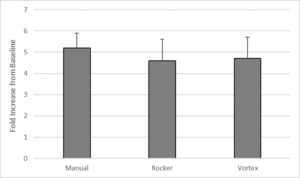
Figure 1: Increase in platelet concentration compared to baseline using the double spin technique for each of the three re-suspension techniques resulted in a 5.2-, 4.6- and 4.7-fold increase for the manual, rocker and vortex methods.
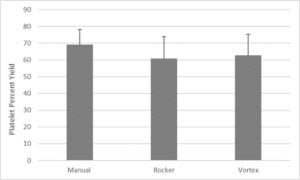
Figure 2: Platelet yield percentage resulted in a 69, 61 and 62% for each of the three re-suspension techniques.
The average platelet concentration of the DS PRP was 4.8x baseline versus 2.0x baseline for the single SS PRP. The WBC yield for the manual, rocker and vortex techniques were 9.3, 7.5 and 10.2% respectively with no differences between groups (p=0.57), while the RBC yield was 0.2, 0.1 and 0.1% respectively with no differences between groups (p=0.26) (Table 2). For all DS PRP groups, the mean RBC and WBC concentration was significantly lower compared to baseline (p<0.01).
|
Resuspension Technique Mean % Yield |
Between Group F-ratio |
P-value |
|||
|
Manual |
Rocker |
Vortex |
|||
|
RBC (sd) |
0.2(.21) |
0.1(.08) |
0.1(.06) |
1.4 |
0.26 |
|
WBC (sd) |
9.3(5.6) |
7.5(4.7) |
10.2(5.8) |
0.6 |
0.57 |
Table 2: Comparative RBC and WBC percent yield among re-suspension techniques.
Cytokine Profile
VEGF and PDGF were quantified for SS-PRP and for the three re-suspension techniques used for DS-PRP. For both growth factors, there was a positive correlation with the platelet concentration. PDGF demonstrated a strong correlation (r=0.78) (Figure 3a) and VEGF demonstrated a weak correlation (r=0.49) (Fig. 3).
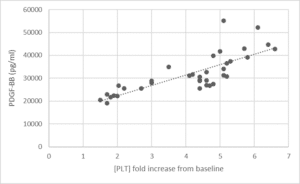

Figure 3: a: The relationship between platelet concentration and VEGF and PGDF shown as a correlation; b: PDGF has a Pearson correlation coefficient of r=0.78 and VEFG has an r=0.49
PDGF-BB
The total concentration of PDGF following manual, rocker and vortex suspension techniques was not different between groups (F=0.2; p=0.81). The average total concentration for the manual, rocker and vortex group was 36090, 33604 and 34497 pg/ml with a range of 2486 pg/ml (Fig. 4). All donors demonstrated an increase in PDGF utilizing the DS spin versus SS technique regardless of re-suspension method.
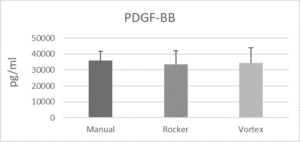
Figure 4: Concentration of PDGF following three re-suspension techniques.
Comparison of increase in [PDGF] for each re-suspension technique with the SS-PRP was 55±11%, 46±23% and 47±25 % (Fig. 5) which was not statistically significant between groups (F=0.82; p=0.45). Intra-individual variability is presented in Fig. 5.
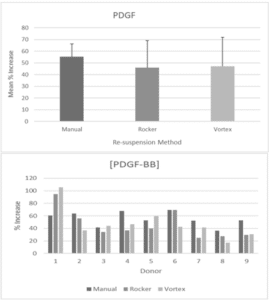
Figure 5: a: Average percent increase of PDGF for each technique; b: Percent increase demonstrated for each of the 9 donors.
VEGF-A
The total concentration of VEGF among the 9 donors revealed no difference between the type of re-suspension (F=.03; p=0.97). The average total concentration among the manual, rocker and vortex group was 232, 211 and 220 pg/ml respectively resulting in a range of 21 pg/ml (Fig. 6). Similar to [PDGF], all [VEGF] concentrations were increased following the DS compared to the SS spin technique. A summary of the growth factor concentrations for each technique is presented in Table 3.
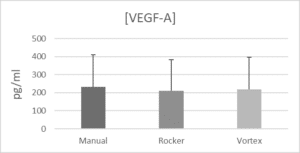
Figure 6: Concentration of VEGF for each re-suspension technique.
|
Resuspension Technique |
Between Group F-ratio |
P-value |
|||
|
Manual |
Rocker |
Vortex |
|||
|
PDGF (pg/mL) |
36090(5704) |
33604(8640) |
34497(9444) |
0.2 |
0.81 |
|
VEGF (pg/mL) |
232(177) |
211(172) |
220(176) |
0.03 |
0.97 |
Table 3: Growth factor expression outcomes following three re-suspension techniques.
Analysis of the percent increase from the SS-PRP for each technique revealed 200±76%, 154±53% and 177±76% with no difference between groups (F=1.0; p=.04) (Fig. 7). There was at least a 69% increase in all donors regardless of technique with an increase over 300% seen in one donor using manual mixing (Fig. 7).
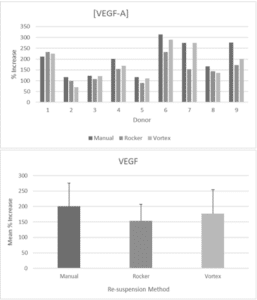
Figure 7: a: Average percent increase of VEGF; b: Percent increase in VEGF of individual donors for each re-suspension technique.
Discussion
With the rapidly increasing clinical use of PRP for various musculoskeletal conditions, there are also a wide variety of methods and protocols utilized. Despite a growing number of high-quality studies, this variability in methodology can make replicating studies an arduous task and comparisons of clinical outcomes difficult. In a review of commercial PRP kits, there were over 30 different commercial kits that met the review criteria and prior studies have demonstrated significant variability in platelet content in some of the more popular commercial kits [1-3]. A recent growing trend has been the development of “in house” PRP preparation techniques which provides greater flexibility to customize PRP cellular characteristics, reduce manufacturing costs and make the service more affordable for patients. We employ a technique similar to that previously described utilizing modified syringes that can be provided to patients at a reduced cost with similar platelet, leukocyte and red blood cell yields and concentrations that are comparable to many commercial kits (see results) [4]. To our surprise, there was no literature available assessing the implications of the resuspension method used in the double spin processing technique. Although this may appear to be a minor step in the preparation process, as it is the final step prior to patient administration, resuspension methods involve different shear stresses which may variably affect platelet concentration and activation, and therefore are clinically relevant. The method of resuspension is also practically relevant as some are more time and labor intensive than others which impacts clinic resources. We found the mean platelet concentration increases were 4.6, 4.7 and 5.2-times baseline and percent yield ranged between 60-70% with no difference between groups. In fact, there was no single result of less than a three-fold platelet concentration increase or less than a 50% yield for any of the re-suspension techniques. This is an important value as it has been suggested that at least a minimum platelet concentration is required to induce an efficient local cellular response for tissue healing and angiogenesis [6]. A primary purpose for utilizing the double spin technique, in addition to minimizing erythrocytes and leukocytes, is to further concentrate platelets. Accordingly, one of our concerns was that the “platelet plug” or aggregation of platelets that remains following the second spin may not be fully re-suspended with certain resuspension methods. This in theory could result in a lower platelet count in the final suspension. In our pilot study there were no significant differences in platelet yield or concentrations between the three re-suspension methods evaluated. Our platelet yield and concentrations are comparable to those of commercial kits that have been previously studied [7,9]. Similar to the platelet quantification results, the percent yield for RBCs and WBCs demonstrated no difference between groups. The average RBC yield among all groups was 0.13% which suggests that the double spin technique is effective at its intended goal of eliminating erythrocytes. The average WBC yield of 9.0% was 2.5% less than that of the single spin yield (11.5%), but it would be difficult to argue that such a small difference would be clinically relevant.
The cytokine profiles of PDGF and VEGF demonstrated no difference in the absolute total concentration or in the percent increase compared to the single spin group. Following the DS protocol, PDGF expression increased by 46, 47 and 55% and VEGF increased by 154, 177 and 200% among the rocker, vortex and manual re-suspension techniques respectively. These results were rather striking in their consistency across all re-suspension techniques as the concept of platelet activation is frequently discussed and considered an important aspect of PRP treatments. As platelet circulate in a quiescent state, it was assumed that the different preparation protocols would variably alter the “activation” of the platelets prior to injection into each patient. Although this is a small pilot study with a limited number of patients, the various re-suspension techniques do not appear to have as great an impact on the growth factor expression as we suspected. We also are cognizant of the fact that with larger numbers and assessment of more growth factors, it is possible that differences could be revealed between groups. Regardless, our study has demonstrated that there is an increase in both PDGF and VEGF independent of the re-suspension technique utilizing our in-house PRP protocol. We have similarly demonstrated a consistent platelet yield of 4.6-5.2x baseline with no difference between the re-suspension groups as well. Within the limitations of our study, the clinical implications of this study are multifold. The manual mixing method is the most labor-intensive requiring 15 minutes of a lab technician’s time to re-suspend the PRP by hand. There are few other tasks the technician can complete during this time. Therefore, if four double spin protocol PRP procedures that utilized manual mixing were performed over the course of the day, one hour of the technician’s time would be consumed solely on re-suspending the PRP. This also prolongs the patient encounter time and potentially reduces the number of patients that can be seen in a day for PRP procedures. The rocker resuspension method is the least labor-intensive in terms of technician time as he/she is free to attend to other duties while the PRP is rocking. However, this does not shorten the patient encounter time. In contrast, the vortex resuspension method requires 5 minutes of dedicated technician time but has the capacity to shorten the overall patient encounter time.
Limitations
As alluded to in the discussion, we acknowledge our results are based on a small sample size and we will need to expand this in our future studies. Due to the prohibitive cost of growth factor analysis, we were limited to assessing only PDGF and VEGF. It would be important to analyze additional anabolic as well as catabolic growth factors to provide a more complete picture. Lastly, our results and conclusions relate only to the 3 resuspension techniques that we chose to evaluate. These results cannot be generalized to all resuspension techniques.
Conclusion
Our pilot study suggests that manual, rocker and vortex resuspension techniques result in an equivalent PRP product in terms of both cellular and growth factor composition. Additional research is encouraged and may include a larger sample size, additional anabolic and catabolic growth factors, and potentially additional resuspension techniques.
Conflict of Interest
The authors have no conflict of interest to declare.
References
- Castillo TN, Pouliot MA, Hyeon Joo Kim, Dragoo JL. Comparison of growth factor and platelet concentration from commercial platelet-rich plasma separation systems. Am J Sports Med. 2011;39(2):266-71.
- Fadadu PP, Mazzola AJ, Hunter CW, Davis TT. Review of concentration yields in commercially available platelet-rich plasma (PRP) systems: A call for PRP standardization. Reg Anesth Pain Med. 2019;44(6):652-9.
- Fitzpatrick J, Bulsara MK, McCrory PR, Richardson MD, Zheng MH. Analysis of platelet-rich plasma extraction: variations in platelet and blood components between 4 common commercial kits. Orthop J Sport Med. 2017;5(1).
- Foster TE, Puskas BL, Mandelbaum BR, Gerhardt MB, Rodeo SA. Platelet-rich plasma: From basic science to clinical applications. Am J Sports Med. 2009;37(11):2259-72.
- Fukaya M, Ito A. A new economic method for preparing platelet-rich plasma. Plast Reconstr Surg. 2014;134(1):1-7.
- Giusti I, Rughetti A, D’Ascenzo S. Identification of an optimal concentration of platelet gel for promoting angiogenesis in human endothelial cells. Transfusion. 2009;49(4):771-8.
- Kushida S, Kakudo N, Morimoto N. Platelet and growth factor concentrations in activated platelet-rich plasma: A comparison of seven commercial separation systems. J Artif Organs. 2014;17(2):186-92.
- Oh JH, Kim W, Park KU, Roh YH. Comparison of the cellular composition and cytokine-release kinetics of various platelet-rich plasma preparations. Am J Sports Med. 2015;43(12):3062-70.
- Oudelaar BW, Peerbooms JC, Huis in ‘t Veld R, Vochteloo AJH. Concentrations of blood components in commercial platelet-rich plasma separation systems: a review of the literature. Am J Sports Med. 2019;47(2):479-87.
- Roh YH, Kim W, Park KU, Oh JH. Cytokine-release kinetics of platelet-rich plasma according to various activation protocols. Bone Jt Res. 2016;5(2):37-45.
Article Type
Research Article
Publication History
Received Date: 22-04-2023
Accepted Date: 08-05-2023
Published Date: 16-05-2023
Copyright© 2023 by Kutcher J, et al. All rights reserved. This is an open access article distributed under the terms of the Creative Commons Attribution License, which permits unrestricted use, distribution, and reproduction in any medium, provided the original author and source are credited.
Citation: Kutcher J, et al. Comparison of Resuspension Techniques on the Cellular and Cytokine Characteristics of Platelet Rich Plasma: A Pilot Study. J Reg Med Biol Res. 2023;4(1):1-10.

Figure 1: Increase in platelet concentration compared to baseline using the double spin technique for each of the three re-suspension techniques resulted in a 5.2-, 4.6- and 4.7-fold increase for the manual, rocker and vortex methods.

Figure 2: Platelet yield percentage resulted in a 69, 61 and 62% for each of the three re-suspension techniques.


Figure 3: a: The relationship between platelet concentration and VEGF and PGDF shown as a correlation; b: PDGF has a Pearson correlation coefficient of r=0.78 and VEFG has an r=0.49.

Figure 4: Concentration of PDGF following three re-suspension techniques.

Figure 5: a: Average percent increase of PDGF for each technique; b: Percent increase demonstrated for each of the 9 donors.

Figure 6: Concentration of VEGF for each re-suspension technique.

Figure 7: a: Average percent increase of VEGF; b: Percent increase in VEGF of individual donors for each re-suspension technique.
Whole Blood Characteristics | Mean +/- SD |
| [Platelet] x 103 cells/µL | 186.2 ± 51.5 |
| [Erythrocyte] x 103 cells/µL | 4159 ± 406 |
| [WBC] x 103 cells/µL | 6.10 ± 1.64 |
Table 1: Whole blood characteristics in 9 healthy donors.
Resuspension Technique Mean % Yield | Between Group F-ratio | P-value | |||
Manual | Rocker | Vortex | |||
RBC (sd) | 0.2(.21) | 0.1(.08) | 0.1(.06) | 1.4 | 0.26 |
WBC (sd) | 9.3(5.6) | 7.5(4.7) | 10.2(5.8) | 0.6 | 0.57 |
Table 2: Comparative RBC and WBC percent yield among re-suspension techniques.
Resuspension Technique | Between Group F-ratio | P-value | |||
Manual | Rocker | Vortex | |||
PDGF (pg/mL) | 36090(5704) | 33604(8640) | 34497(9444) | 0.2 | 0.81 |
VEGF (pg/mL) | 232(177) | 211(172) | 220(176) | 0.03 | 0.97 |
Table 3: Growth factor expression outcomes following three re-suspension techniques.


